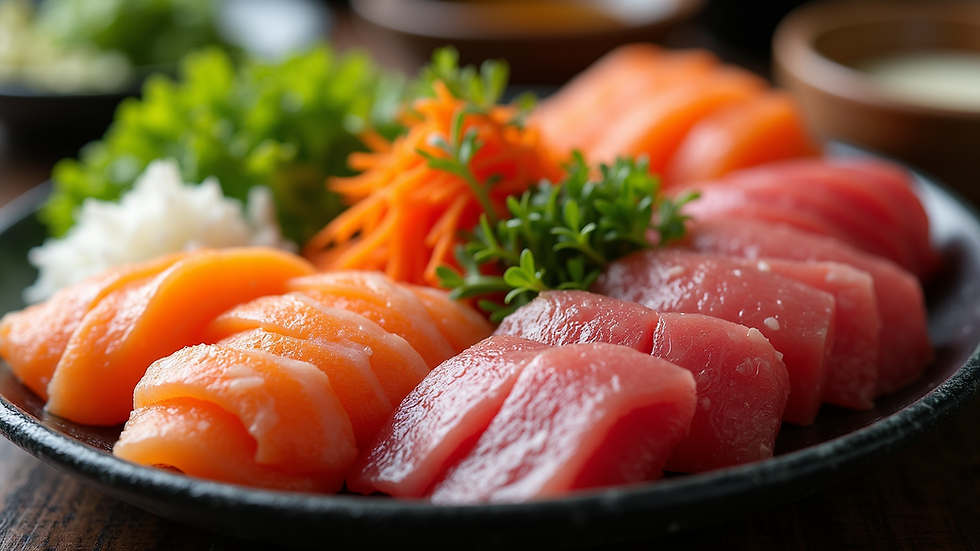Exploring the Unseen Aspects of Korean Sushi Culture and Its Culinary Delights
- Crea GPT

- Jun 5
- 3 min read
Korean sushi, simply referred to as "sushi" in Korea, carries a unique flair that distinguishes it from its Japanese counterpart. While many think of sushi in terms of delicate rolls and raw fish, Korean variations introduce a multitude of flavors, cultural meanings, and preparation styles. This post highlights the fascinating elements of Korean sushi culture, focusing on traditional practices, essential ingredients, and innovative culinary techniques.
The Essence of Korean Sushi
Korean sushi is known for its diverse ingredients and flavors that echo the country's culinary heritage. While Japanese sushi often highlights seafood, Korean sushi incorporates a wider range of components, making it an exciting experience for food lovers.
Koreans create various types of sushi that explore different textures and tastes. Gimbap, a well-loved rice roll filled with vegetables and proteins, exemplifies this diversity. Unlike Japanese sushi, which often emphasizes raw ingredients, gimbap is about blending familiar tastes to create a dish that is both inviting and comforting.
Popular Types of Korean Sushi
Gimbap: A Korean Classic
Gimbap stands as the most recognized style of Korean sushi known for its colorful appearance and rich fillings. Although it may look similar to Japanese maki rolls, gimbap is unique due to the use of sesame oil-infused rice, which contributes a delightful nutty flavor. Typical fillings include:
Vegetables: Pickled radish, cucumber, and carrots
Proteins: Beef, fish cake, or egg

Gimbap is often enjoyed as a snack during picnics and represents the essence of Korean communal dining. It’s not just food but a reflection of the warmth found within Korean culture and is popularly prepared during family gatherings.
Chueotang: A Flavorful Fish Soup
Chueotang, or mudfish soup, adds depth to Korean sushi culture. Made from fresh mudfish simmered with spicy seasonings and vegetables, this dish differs from traditional sushi but highlights the innovation in using fish within Korean cuisine.
Chueotang is hearty and comforting and often served in family settings. Unlike conventional sushi that often features raw fish, Korean dishes embrace cooking methods that showcase fish in a versatile manner.
The Making of Korean Sushi
Traditional Techniques
Making Korean sushi is an art that involves careful preparation and a range of traditional techniques passed down through generations. The rice is often seasoned with a blend of vinegar and sesame oil, offering a balanced flavor.
Preparation also includes slicing ingredients uniformly. For example, vegetables are cut to ensure they deliver consistent taste and texture throughout each bite, and proteins are marinated to enhance their flavors.
Fusion of Flavors
Korean sushi increasingly features fusion elements, blending Western ingredients with local traditions. This creative adaptation has given rise to dishes like the California roll, which includes local ingredients such as avocado and crab alongside traditional elements.
Additionally, chefs experiment with unique toppings and sauces, enhancing traditional dishes and creating modern interpretations that attract both locals and international diners.
Cultural Significance of Sushi in Korea
A Dish of Celebration
In Korean culture, sushi plays an essential role in celebrations and gatherings. It is featured prominently during occasions like birthdays and weddings, where beautifully arranged platters of gimbap and raw fish dishes symbolize hospitality and community.
Sharing sushi reinforces connections among family and friends, showcasing the sense of "jeong," the emotional bonds nurtured through food.
The Influence of Globalization
Like many aspects of Korean cuisine, sushi has evolved through globalization. The rise of K-dramas and K-pop has spurred interest in Korean food worldwide. As a result, Korean sushi has adapted to local preferences, leading to unique culinary creations in different countries.
Despite the innovative changes, the traditional aspects continue to thrive, ensuring both authentic and modern forms of sushi are appreciated both locally and abroad.
The Best Places to Experience Korean Sushi
If you want to indulge in authentic Korean sushi, there are several outstanding locations to explore, ranging from bustling markets to fine restaurants.
Traditional Markets
Visiting a lively market such as Gwangjang Market in Seoul offers a chance to taste freshly made gimbap alongside other sushi-related dishes prepared by local vendors. The vibrant environment and diverse offerings immerse visitors into the heart of Korean food culture.
Fine Dining
For those seeking an upscale experience, restaurants like "Sushi O" and "Mugunghwa" provide a contemporary twist on Korean sushi. These establishments focus on seasonal ingredients and artistic presentations, catering to patrons looking for intricate culinary experiences.
Discovering the Delights of Korean Sushi
Korean sushi culture represents a fascinating blend of history and innovation while reflecting the country’s rich culinary landscape. From cherished dishes like gimbap to delightful flavors found in chueotang, this cuisine invites exploration.
As global interest in Korean dishes grows, sushi stands as a testament to the celebration of culture and community. Whether you're a sushi aficionado or a curious newcomer, there’s always more to discover in the wonderful world of Korean sushi.

$50
Product Title
Product Details goes here with the simple product description and more information can be seen by clicking the see more button. Product Details goes here with the simple product description and more information can be seen by clicking the see more button

$50
Product Title
Product Details goes here with the simple product description and more information can be seen by clicking the see more button. Product Details goes here with the simple product description and more information can be seen by clicking the see more button.

$50
Product Title
Product Details goes here with the simple product description and more information can be seen by clicking the see more button. Product Details goes here with the simple product description and more information can be seen by clicking the see more button.




Comments